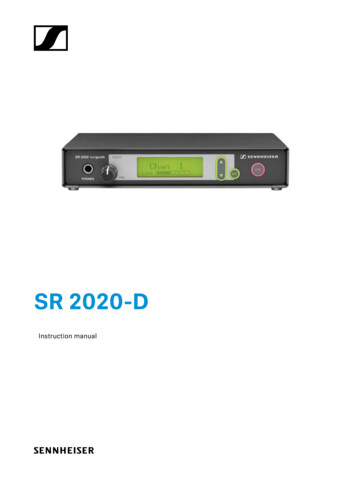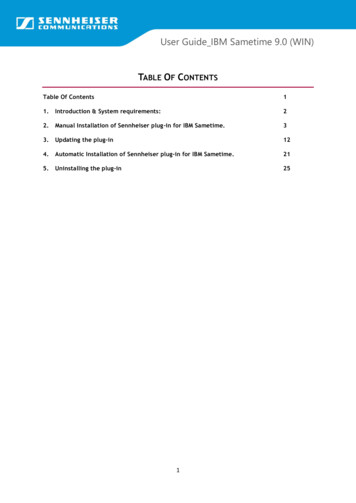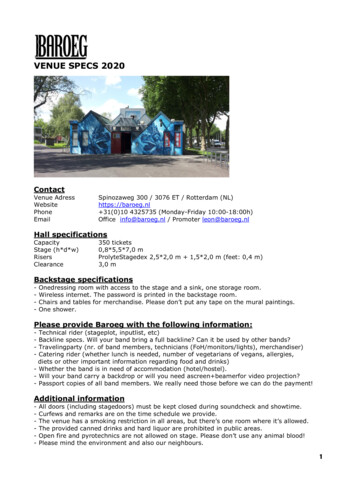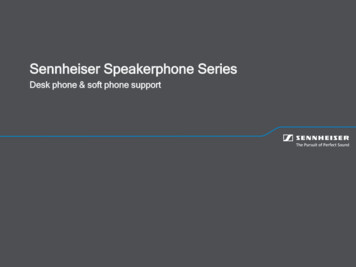
Transcription
SR 2020-DInstruction manual
Important safety instructionsImportant safety instructions1. Read these safety instructions and the instruction manual of the product.2. Keep these safety instructions and the instruction manual of the product. Always includeall instructions when passing the product on to third parties.3. Heed all warnings.4. Follow all instructions.5. Do not use this apparatus near water.6. Only clean the product when it is not connected to the power supply system. Clean onlywith a dry cloth.7. Do not block any ventilation openings. Install in accordance with the manufacturer‘sinstructions.8. Do not install near any heat sources such as radiators, heat registers, stoves, or otherapparatus (including amplifiers) that produce heat.9. Only operate the product from the type of power source specified in the chapter „Specifications“ and indicated on the power supply unit.10. Protect the power cord from being walked on or pinched, particularly at plugs, convenience receptacles, and the point where it exits from the apparatus.11. Only use attachments/accessories specified by the manufacturer.12. Use only with the cart, stand, tripod, bracket, or table specified by the manufacturer, orsold with the apparatus. When a cart is used, use caution when moving the cart/apparatus combination to avoid injury from tip-over.13. Unplug the power supply unit from the wall socket, to completely disconnect the product from the power supply system, during lightning storms, when not using the product for long periods of time.14. Refer all servicing to qualified service personnel. Servicing is required when the apparatus has been damaged in any way, such as power-supply cord or plug is damaged, liquidhas been spilled or objects have fallen into the apparatus, when the apparatus has beenexposed to rain or moisture, does not operate normally, or has been dropped.15. Only use the supplied power supply unit.16. Warning: To reduce the risk of fire or electric shock, do not expose this apparatus to rainor moisture and objects filled with liquids, such as vases, should not be placed on thisapparatus.17. When using the supplied device feet, do not place the product on delicate surfaces. Delicate surfaces can become discolored or stained when they come into contact with theplastic of the device feet.18. Always ensure that the power supply unit is in a safe operating condition and easily accessible, properly plugged into the wall socket, only operated within the permissible temperature range, not covered or exposed to direct sunlight for longer periods of time in order to preventheat accumulation.SR 2020-D 1
Important safety instructionsRisk of fire due to overloadingDo not overload wall outlets and extension cables as this may result in fire and electricshock.Replacement partsWhen replacement parts are required, be sure the service technician uses replacement partsspecified by Sennheiser or those having the same characteristics as the original part. Unauthorized substitutions may result in fire, electric shock, or other hazards.Danger due to high volume levelsThis product is used for commercial purposes. Commercial use is subject to the rules andregulations of the trade association responsible. Sennheiser, as the manufacturer, is therefore obliged to expressly point out possible health risks arising from use.This product is capable of producing sound pressure levels exceeding 85 dB(A). 85 dB(A) isthe sound pressure corresponding to the maximum permissible volume which is by law (insome countries) allowed to affect your hearing for the duration of a working day. It is usedas a basis according to the specifications of industrial medicine. Higher volumes or longerdurations can damage your hearing. At higher volumes, the duration must be shortened inorder to prevent hearing damage.The following are sure signs that you have been subjected to excessive noise for too long atime: You can hear ringing or whistling sounds in your ears. You have the impression (even for a short time only) that you can no longer hear highnotes.Inform all users of these risks and ask them to set the volume to a moderate level if necessary.Intended useThe product is designed for indoor and outdoor use.The product can be used for commercial purposes.It is considered improper use when the product is used for any application not named in thecorresponding instruction manual.Sennheiser does not accept liability for damage arising from improper use or misuse of thisproduct and its attachments/accessories.Before putting the products into operation, please observe the respective country-specificregulations!Sennheiser is not liable for damages resulting from the loss of connection due to flat or overaged (rechargeable) batteries or exceeding the transmission range.2 SR 2020-D
Delivery includesDelivery includes SR 2020-D transmitter NT 2-3 mains unit Telescopic antenna GA 2 rack adapter, consisting of 2 rack mount “ears” Blanking plate Jointing plate 2 blanking plugs for closing off unused BNC holes 12 recessed head screws M 3x6 2 recessed head screws M 6x10 4 device feet Instruction manual Manufacturer declarationsSystem componentsThe SR 2020-D transmitter allows the stationary use of the Tourguide 2020-D system.The transmitter can be combined with the following individual components: HDE 2020-D-II stethoset receivers EK 2020-D-II receiversSR 2020-D 3
Tourguide system overviewTourguide system overviewTogether with the SR 2020-D transmitter, the Tourguide 2020-D system offers optimum digital speech transmission for the following applications: simultaneous interpretations and stationary guided toursAreas of applicationSimultaneous interpretations during conferences (“Conference“ mode)The main application of the stationary SR 2020-D transmitter is its use for simultaneousinterpretations during conferences.Eight fixed transmission frequencies allow for interference-free simultaneous interpretationsin up to eight languages (see “Transmitting several languages simultaneously” on page 17).tourguidetourguide4 SR 2020-D
Tourguide system overviewStationary guided tours (“Tourguide“ mode)With a stationary guided tour, both the group and the transmitters are in a fixed location.Examples for stationary guided tours are multimedia presentations, movie shows as well asboat and bus tours in several languages.Six fixed transmission frequencies allow for simultaneous transmission in up to six languages(see “Transmitting several languages simultaneously” on page 17).The Tourguide 2020-D system operates in the 863 MHz–865 MHz frequency band, which islicense-free in Europe (see „Specifications“ on page 22).Connection possibilitiesYou can connect one of the following phantom-powered Sennheiser condenser microphones(not included) to the SR 2020-D transmitter: ME 34, ME 35, ME 36In addition, you can connect an audio source to the transmitter: Conference/interpretation systems MP3 player CD /DVD playerSR 2020-D 5
Product overviewProduct overview123456tourguide2798101Headphone output (PHONES),¼” (6.3 mm) jack socket2Headphone volume control (VOL)71112Cable grip for mains cable8 Socket for connection of mains unit(DC IN 12 V/300 mA)3 Display, backlit9 Audio input (AF IN MIC/LINE), XLR-3Fsocket5 SET button, backlit10 Service interface (DATA)6 ON button, backlit (serves as the ESC(cancel) key in the operating menu)12 Antenna output (ANT), BNC socket4 rocker button / , backlit11 Type plate1 Display for the selected signal source(„Mic“/„Line“)2 Mic-/Line level display3 Channel display4 Lock mode icon (lock mode is activated)6 SR 2020-D
Product overviewIndications and displays on the transmitterDisplay for the selected signal source (Mic/Line)You can connect either a condenser microphone or an external audio source to the transmitter.If you connect a condenser microphone, select “Mic” via the operating menu. If you connectan external audio source, select “Line” (see page 19).“Mic” or “Line” appears on the display 1.Note: If the “Mic” microphone input is selected but no microphone is connected, “No Mic”appears on the display.Mic/Line level displayThe Mic-/Line level display 2 shows the input level.When the transmitter’s audio input level is excessively high, the Mic-/Line level display 2shows full deflection.In addition, the display panel is in backlit in red and the text “PEAK” flashes in alternationwith the channel display (see page 19).Channel displayThe channel display 3 provides information on the currently selected channel (see page 17).Lock mode iconThe lock mode icon 4 appears when the lock mode is activated (see page 20).SR 2020-D 7
Putting the SR 2020-D into operationPutting the SR 2020-D into operationPreparing the transmitter for useYou can set up the SR 2020-D transmitter on an even surface or mount it into a 19" rack.Note: Do not fit the rubber feet when rack mounting the transmitter.Setting up the transmitter on an even surfaceTo ensure that the transmitter cannot slip on the surface on which it is placed, four self-adhesive soft rubber feet are supplied.CAUTIONRISK OF STAINING OF FURNITURE SURFACES!Some furniture surfaces have been treated with varnish, polish or synthetics which mightcause stains when they come into contact with other synthetics.Despite a thorough testing of the synthetics used by us, we cannot rule out the possibility ofstaining.Do not place the transmitter on delicate surfaces.Ensure that the base of the transmitter is clean and free from grease before mounting therubber feet.Fix the rubber feet to the base of the transmitter by peeling of the safety paper and fittingthem as shown in the diagram.Connecting the antennaConnect the telescopic antenna to the antenna output 12 at the rear of the transmitter.To obtain the best possible radiation power:Align the antenna vertically.128 SR 2020-D
Putting the SR 2020-D into operationRack-mountingCAUTIONRISKS WHEN RACK MOUNTING THE TRANSMITTER!When installing the device in a closed or multi-rack assembly, please consider that, duringoperation, the ambient temperature, the mechanical loading and the electrical potentials willbe different from those of devices which are not mounted into a rack:The ambient temperature within the rack must not exceed the temperature limit specifiedin the specifications.When installing the device in a rack, take good care not to affect the ventilation requiredfor safe operation. If necessary, provide additional ventilation.Make sure the mechanical loading of the rack is even to avoid a hazardous condition suchas a severely unbalanced rack.When connecting the device to the mains, observe the information indicated on the typeplate. Avoid circuit overloading. If necessary, provide overcurrent protection.When installing the device in a closed or multi-rack assembly, please note that intrinsically harmless leakage currents of the individual mains units may accumulate, therebyexceeding the allowable limit value. As a remedy, ground the rack via an additional groundconnection.Mounting the antennas to the front or rear of the rackFor the best possible radiation power, you should align the antennas vertically. If this is notpossible, use one of the optional antenna mounts (see “Accessories and spare parts” on page25): You mount 1 transmitter: Antenna mount AM 2 You mount 2 transmitters: Antenna mount GA 3030 AMWhen using several transmitters simultaneously, make sure that, in order to avoid interference, the distance between the antennas is sufficient. If necessary, use active transmittercombiners (see “Accessories and spare parts” on page 25): You mount 4 transmitter: Active Transmitter Combiner AC 3 You mount 8 transmitters: Active Transmitter Combiner AC 3200-IIIf you want to mount the antennas outside the rack, you can use remote antennas (see “Accessories and spare parts” on page 25).SR 2020-D 9
Putting the SR 2020-D into operationMounting two SR 2020-D side by sidePlace the two transmitters side by side upside-down onto a flat surface.Align the jointing plate 15 over the holes in the bottom sides of the transmitters.Secure the jointing plate 15 to the transmitters using eight of the supplied recessed headscrews (M 3x6).Hook the two rack mount “ears” 14 to the front panels of the transmitters.Secure the rack mount “ears” 14 to the transmitters using two of the supplied recessedhead screws (M 3x6) respectively. If you wish to mount the antenna connections to thefront of the rack, use the rack mount “ears” of the optional GA 3030 AM antenna mount.Slide the transmitters into the 19" rack.Secure the rack mount “ears” 14 to the rack.141415Mounting only one SR 2020-DWhen mounting only one transmitter into the rack, use the blanking plate 13 instead of thesecond transmitter.Hook the two rack mount “ears” 14 to the front panel of the transmitter.Secure the rack mount “ears” 14 to the transmitter using two of the supplied recessed headscrews (M 3x6) respectively.Secure the blanking plate 13 to one of the rack mount “ears” 14 using two of the suppliedrecessed head screws (M 6x10).If you are not front mounting the BNC output connector, insert the two blanking plugs 16into the holes of the blanking plate.Slide the transmitter into the 19" rack.Secure the rack mount “ears” 14 to the rack.10 SR 2020-D
Putting the SR 2020-D into operation13161414Connecting the transmitter to the mainsPass the cable through the cable grip 7.Connect the cable of the mains unit to the DC IN socket 8 of the transmitter.Plug the mains connector into the wall socket.7 82Connecting external devicesYou can connect either a microphone (Mic) or an external audio source (Line, e.g. CD or MP3player) to the transmitter.To do so, use a suitable audio cable with a length of up to 3 m.Connecting an external audio source to the transmitterConnect the line output of the external audio source to the XLR-3F socket 9 of the transmitter.92SR 2020-D 11
Putting the SR 2020-D into operationConnecting a condenser microphoneThe microphone input of the SR 2020-D transmitter is exclusively designed for use with condenser microphones. Suitable microphones are listed on page 5.Connect the condenser microphone to the XLR-3F socket 9 of the transmitter.92Connecting the headphonesThe Mic/Line level display 2 displays the strength of the input signal (see page 7). TheSR 2020-D transmitter also features a headphone output for monitoring purposes.CAUTIONDANGER OF HEARING DAMAGE!Listening at high volume levels for long periods can lead to permanent hearing defects.Use the headphone volume control (VOL) 2 to set the volume for the connected headphones to the minimum before putting the headphones on.To monitor the audio signal via headphones:Set the headphone volume control 2 to the lowest volume by turning it to the left as far aspossible.Connect headphones with a ¼" (6.3 mm) stereo jack plug to the headphone output 1.Put the headphones on.Gradually turn up the volume.1212 SR 2020-D
Operating the SR 2020-DOperating the SR 2020-DSwitching the transmitter on/offTo switch the transmitter on:Press the ON button 6.The display panel indicates the device name and then switches to the standard display.6tourguideTo switch the transmitter off:Press the ON button 6 until “OFF” appears on the display.Release the ON button 6.The display panel goes off and the transmitter switches off.Note: The transmitter can only be switched off when the standard display is shown on thedisplay panel. When in the operating menu, the ON button 6 serves as the ESC (cancel) key,i.e. you cancel your entry and return to the standard display.Working with the operating menuBy way of example of the „Chan. mode“ menu (Channel mode) this section describes how touse the operating menu.For an overview of the operating menu, please see page 19.Make sure that the lock mode is deactivated (see page 18).Getting into the operating menuTo get from the standard display into the operating menu:Press the SET button 5.The „Channel“ menu is highlighted with a black bar.5tourguideSR 2020-D 13
Operating the SR 2020-DSelecting a menuUse the / rocker button 4 to select the „Chan. mode“ menu:Rocker buttonpress press keep or pressedDisplayjumps to the previous menujumps to the next menucycles continuously4tourguidePress the SET button 5 to get into the setting mode of the „Chan. mode“ menu.The current setting of the menu is displayed.Adjusting a setting in the setting modeUse the / rocker button 4 to jump between the settings.Storing a settingPress the SET button 5 to store the selected setting.„STORED“ briefly appears on the display.Exiting a menuPress the ON button 6 to return to the operating menu.Exiting the operating menuUse the / rocker button 4 to select the „Exit“ menu and press the SET button 5.The standard display is shown on the display panel.Or:Press the ON button 6 until the standard display is shown on the display panel.14 SR 2020-D
Operating the SR 2020-DSelecting the menusThe transmitter’s operating menu contains the following menus:Menu“Channel”“Frequency”“Chan. ”Function of the menuSelecting a channel (see page 15)Displaying the frequency of the current channel (see page 16)Selecting the channel mode (see page 16)Selecting the input signal (see page 17)Adjusting the input sensitivity (see page 17)Displaying the phantom power (see page 17)Adjusting the contrast (see page 17)Activating/deactivating the lock mode (see page 18)Loading the factory-preset default settings (see page 18)Displaying the current software version (see page 18)Exiting the operating menuSetting a channel (“Channel”)To set a certain channel, proceed as follows:Make sure that the transmitter and the receivers are set to the same channel mode (“Tourguide” or “Conference”), otherwise no connection can be established (see page 16).Set the SR 2020-D transmitter to the desired channel (see next section).Set one of the receivers to the same channel.Automatically set all other receivers to the same channel using the channel copy function(for information on the channel copy function, please refer to the instruction manual of theTourguide 2020 system).To set the transmitter to the desired channel:Select the „Channel“ menu.„Channel“ appears on the display and the current channel is shown.the / rocker button 4 to change the channel.Press the SET button 5 to store the selected channel.Transmitting several languages simultaneouslyIn order to be able to transmit several languages simultaneously, you require one SR 2020-Dtransmitter and one or several receivers per language:Set the transmitter and the receivers assigned to certain language to the same channel.Do not use this channel for any other language.SR 2020-D 15
Operating the SR 2020-DDisplaying the frequency of the selected channel (“Frequency”)You can display the frequency of the selected channel. This function is useful, if you areusing other Tourguide systems in the vicinity which interfere with your transmission (seeprevious section).Select the „Frequency“ menu.„Frequency“ appears on the display and the frequency of the current channel is shown.Changing the channel mode (“Chan. mode”)You can choose between the two channel modes “Conference” and “Tourguide”. The twomodes have been designed for different applications and differ from each other in the number of available channels:Channel modeApplicationNumber of channelsConferenceSimultaneous interpretations8TourguideTourguide systems6To change the channel mode:Select the „Chan. mode“ menu.Use the / rocker button 4 to to change the channel mode („Tourguide“/„Conference“).Press the SET button 5 to store the selected channel mode.Display of the channel modeThe selected channel mode appears on the standard display as follows:DisplayChannel mode„Tourguide“„Conference“16 SR 2020-D
Operating the SR 2020-DSelecting the input signal (“Input”)You can connect either a condenser microphone or any other audio source (e.g. CD and MP3player, see page 5) to the transmitter.To select the input signal:Select the „Input“ menu.Press the SET button 5 to display the current setting („Mic“/„Line“).Use the / rocker button 4 to select the desired input signal:You connect .Selecta condenser microphone?„Mic“an external audio source?„Line“Press the SET button 5 to store the selected input signal.Adjusting the sensitivity of the Mic/Line input (“Sensitiv”)If you connect a microphone to the transmitter, the microphone signal has to be amplifiedby the transmitter. Other audio sources can be amplified, if their audio signal is too low (seepage 17).To adjust the input sensitivity:Select the „Sensitiv“ menu.Use the / rocker button 4 to change the setting. The Mic/Line level display 2 shouldshow full deflection during the loudest passages.Press the SET button SET 5 to store the input sensitivity of the Mic / Line input.Displaying the phantom power (“Phantom”)When you activate the transmitter’s microphone input, the phantom power is automaticallyavailable (see page 17). The display show the value of the phantom power.Adjusting the contrast of the display (“Contrast”)To adjust the contrast of the display to the ambient light:Select the „Contrast“ menu.„Contrast“ appears on the display and the current setting is shown.Use the / rocker button 4 to change the setting.Press the SET button 5 to store the setting.SR 2020-D 17
Operating the SR 2020-DActivating/deactivating the lock mode (“Lock”)The lock mode prevents that the transmitter is accidentally programmed or switched offduring operation.To activate the lock mode:Select the „Lock“ menu.Select the setting „Lock On“.Press the SET button 5.The lock mode is activated and the lock mode icon appears on the standard display.To deactivate the lock mode:Press the SET button 5.„Lock On“ appears on the display.Select the setting „Lock Off“.Press the SET button 5 to deactivate the lock mode.The lock mode icon disappears from the standard display.Loading the factory-preset default settings (“Reset”)Select the „Reset“ menu.„Reset No“ appears on the display.Press the / rocker button 4 until „Reset Yes“ appears on the display.Press the SET button 5 to reset the device to the factory-preset default settings.„DONE“ appears on the display. The transmitter is reset to the following factory-presetdefault settings: Channel mode: Tourguide Input signal: Line input Channel: 1 Input sensitivities: Line input: 0 dB Microphone input: 0 dBLock mode: deactivatedDisplaying the version number of the software (“Version”)Note: This function is for servicing purposes only.To display the version number:Select the “Version” menu.The version number appears on the display.18 SR 2020-D
Operating the SR 2020-DOverview of the operating menuPressing the ON button 6 will cancel your entry in all menu modes.Selection modeEXITSR 2020-D3 SecCHAN 01Setting modeSETChannel1Selectingthe channelSETSET,ONChannel 1Channel 6Current channel/ : 1.6/8SET: Stores the settingSETSTOREDFrequency863.124SETDisplayingthe frequencyFrequency863.124Current settingON, SETChan. modeTourguideSettingthe channelmodeSETSET,ONChan. modeTourguideChan. modeConferenceCurrent setting/SET: Stores the ting theinput signalSET,ONCurrent setting/SET: Stores the settingSETSTOREDSensitiv0 dBSETSensitiv0 dBSensitiv– 36 dBSettingthe inputsensitivitySET,ONCurrent setting/STOREDMic: 0 to -36dBLine: 0 to -24dBSET: Stores the settingSETPhantom powerSR 2020-D 19
Operating the SR 2020-DSelection modeSetting modeSensitivPhantom48 VDisplaying thephantom powerContrastAdjustingthe contrastSETSET,ONSETSET,ONPhantom48 VCurrent settingContrastContrastCurrent setting/ :SET: Stores the settingSETSTOREDLockOffActivating/deactivatingthe lock modeSETSET,ONLockOffLockOnCurrent settingSET/SET: Stores the settingSTOREDResetNoSETLoading thefactory-presetdefault settingsResetNoResetYesCurrent setting/Displaying thesoftware versionExit20 SR 2020-DSET: Stores the 0.0.0Current settingSET
Cleaning the SR 2020-DCleaning the SR 2020-DCAUTIONLIQUIDS CAN DAMAGE THE ELECTRONICS OF THE TRANSMITTER!Liquids entering the housing of the device can cause a short-circuit and damage the electronics.Keep all liquids away from the device.Do not use any solvents or cleansing agents.Before cleaning, disconnect the device from the mains.Only use a soft and dry cloth to clean the device.If a problem occursProblemNo operation indicationon the transmitterAudio signal is distortedOccasional drop outs inthe audio signalNo radio waves on thereceiver displayPossible causeNo mains connectionTransmitter sensitivity isadjusted too highDistance to the transmitter is too greatInterference of unknownoriginInterference is beingreceived from a secondtransmitterAntenna is badly positionedNo RF signal: transmitterand receiver are not onthe same channelNo RF signal: transmission range is exceededPossible remedyCheck the mains unit and the connection to the DC IN socket (seepage 11)Change the sensitivity of the microphone input or line input (seepage 17)Select the source of the input signal(see page 17)Reduce the distance to the transmitterSet the transmitter and receiver to adifferent channel (see page 15)Change the transmitters to differentchannels (see page 15)Improve the position of the transmitting antenna: Mount the antenna tothe front of the rack or use a remoteantennaSet the transmitter and receiver tothe same channel (see page 15)Reduce the distance between receiver and transmitterImprove the position of the transmitting antennaIf a problem occurs that is not listed in the above table or if the problem cannot be solvedwith the proposed solutions, please contact your local Sennheiser agent for assistance.SR 2020-D 21
SpecificationsSpecificationsSR 2020-D transmitter (Art. No.: 500550)SR 2020-D-US transmitter (Art. No.: 500551)Modulation2 FSKFrequency range863 – 865 MHzFrequency range (US)926 – 928 MHzChannelstourguide modeconference mode6 in parallel8 in parallelFrequency response100 – 7,000 HzSignal-to-noise-ration 70 dB(A)THD 1 % (@ 1kHz)Input voltage range160 mV – 2.5 V (Mic),2 mV – 125 mV (Line)Phantom Powering48 VPower supply12 V (10,5 V – 16 V)Current consumptionmax. 300 mATemperature0 – 50 CRange Indoorup to 50 mRange Outdoorup to 100 mDimensions212 x 145 x 38 mmWeight1100 gNT 2-3 CW mains unitInput voltage100 - 240 V , 50 – 60 HzCurrent consumptionmax. 120 mAOutput voltage12 V Output current400 mATemperature-10 C – 55 C(32 F – 131 F)Weightapprox. 160 g22 SR 2020-D
AccessoriesAccessoriesProduct nameProduct descriptionArt. No.Telescopic antenna072817Device feet (4 pieces)082875HDE 2020-D-II-IIStethoset receiver504796HDE 2020-D-II-II-USStethoset receiver (US)504797EK 2020-D-IIReceiver504794EK 2020-D-II-USReceiver (US)504795GA 3030-AMAntenna mount (2 transmitters)004368AM 2Antenna mount for GA 2 rack adapter (1 transmitter)009912AC 3Active transmitter combiner for 4 transmitters503166AC 3200-IIActive transmitter combiner for 8 transmitters505497A 2003-UHFRemote antenna003658A 1031-URemote antenna004645NT 2-3-EUMains unit (EU)503157NT 2-3-USMains unit (US)503870NT 2-3-UKMains unit (UK)503871SR 2020-D 23
Sennheiser electronic GmbH & Co. KGAm Labor 1, 30900 Wedemark, Germany, www.sennheiser.comPrinted in Germany, Publ. 05/19, 583933/A01
Together with the SR 2020-D transmitter, the Tourguide 2020-D system offers optimum digi-tal speech transmission for the following applications: simultaneous interpretations and stationary guided tours Areas of application Simultaneous interpretations during conferences ("Conference" mode)










